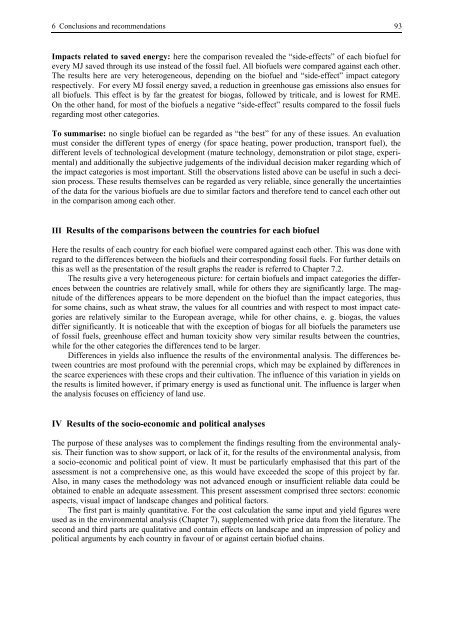BIOENERGY FOR EUROPE: WHICH ONES FIT BEST?
BIOENERGY FOR EUROPE: WHICH ONES FIT BEST?
BIOENERGY FOR EUROPE: WHICH ONES FIT BEST?
You also want an ePaper? Increase the reach of your titles
YUMPU automatically turns print PDFs into web optimized ePapers that Google loves.
6 Conclusions and recommendations 93<br />
Impacts related to saved energy: here the comparison revealed the “side-effects” of each biofuel for<br />
every MJ saved through its use instead of the fossil fuel. All biofuels were compared against each other.<br />
The results here are very heterogeneous, depending on the biofuel and “side-effect” impact category<br />
respectively. For every MJ fossil energy saved, a reduction in greenhouse gas emissions also ensues for<br />
all biofuels. This effect is by far the greatest for biogas, followed by triticale, and is lowest for RME.<br />
On the other hand, for most of the biofuels a negative “side-effect” results compared to the fossil fuels<br />
regarding most other categories.<br />
To summarise: no single biofuel can be regarded as “the best” for any of these issues. An evaluation<br />
must consider the different types of energy (for space heating, power production, transport fuel), the<br />
different levels of technological development (mature technology, demonstration or pilot stage, experimental)<br />
and additionally the subjective judgements of the individual decision maker regarding which of<br />
the impact categories is most important. Still the observations listed above can be useful in such a decision<br />
process. These results themselves can be regarded as very reliable, since generally the uncertainties<br />
of the data for the various biofuels are due to similar factors and therefore tend to cancel each other out<br />
in the comparison among each other.<br />
III Results of the comparisons between the countries for each biofuel<br />
Here the results of each country for each biofuel were compared against each other. This was done with<br />
regard to the differences between the biofuels and their corresponding fossil fuels. For further details on<br />
this as well as the presentation of the result graphs the reader is referred to Chapter 7.2.<br />
The results give a very heterogeneous picture: for certain biofuels and impact categories the differences<br />
between the countries are relatively small, while for others they are significantly large. The magnitude<br />
of the differences appears to be more dependent on the biofuel than the impact categories, thus<br />
for some chains, such as wheat straw, the values for all countries and with respect to most impact categories<br />
are relatively similar to the European average, while for other chains, e. g. biogas, the values<br />
differ significantly. It is noticeable that with the exception of biogas for all biofuels the parameters use<br />
of fossil fuels, greenhouse effect and human toxicity show very similar results between the countries,<br />
while for the other categories the differences tend to be larger.<br />
Differences in yields also influence the results of the environmental analysis. The differences between<br />
countries are most profound with the perennial crops, which may be explained by differences in<br />
the scarce experiences with these crops and their cultivation. The influence of this variation in yields on<br />
the results is limited however, if primary energy is used as functional unit. The influence is larger when<br />
the analysis focuses on efficiency of land use.<br />
IV Results of the socio-economic and political analyses<br />
The purpose of these analyses was to complement the findings resulting from the environmental analysis.<br />
Their function was to show support, or lack of it, for the results of the environmental analysis, from<br />
a socio-economic and political point of view. It must be particularly emphasised that this part of the<br />
assessment is not a comprehensive one, as this would have exceeded the scope of this project by far.<br />
Also, in many cases the methodology was not advanced enough or insufficient reliable data could be<br />
obtained to enable an adequate assessment. This present assessment comprised three sectors: economic<br />
aspects, visual impact of landscape changes and political factors.<br />
The first part is mainly quantitative. For the cost calculation the same input and yield figures were<br />
used as in the environmental analysis (Chapter 7), supplemented with price data from the literature. The<br />
second and third parts are qualitative and contain effects on landscape and an impression of policy and<br />
political arguments by each country in favour of or against certain biofuel chains.

















